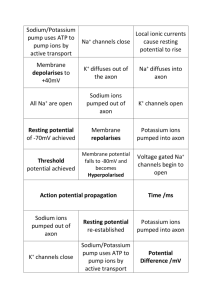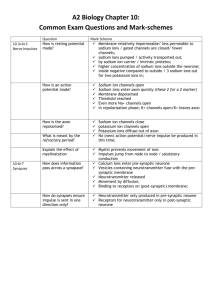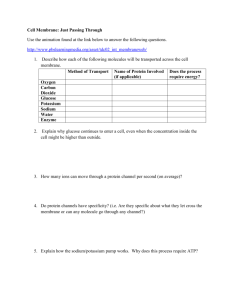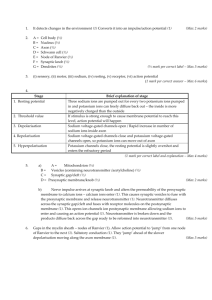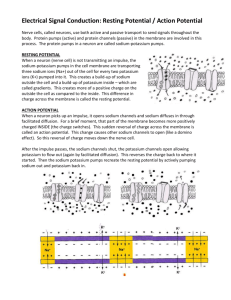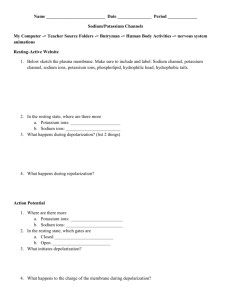mm/ms. Plot © 1 2 versus at time 3 4' ms. mm/ms. Plot © 1 2 versus
advertisement
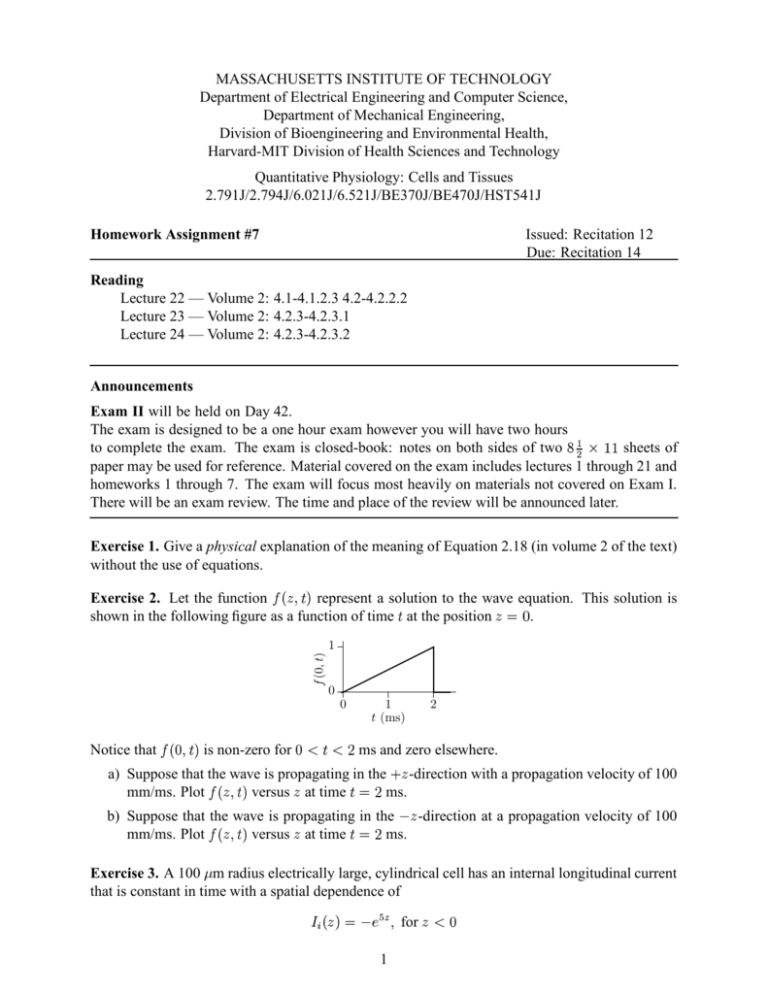
MASSACHUSETTS INSTITUTE OF TECHNOLOGY
Department of Electrical Engineering and Computer Science,
Department of Mechanical Engineering,
Division of Bioengineering and Environmental Health,
Harvard-MIT Division of Health Sciences and Technology
Quantitative Physiology: Cells and Tissues
2.791J/2.794J/6.021J/6.521J/BE370J/BE470J/HST541J
Homework Assignment #7
Issued: Recitation 12
Due: Recitation 14
Reading
Lecture 22 — Volume 2: 4.1-4.1.2.3 4.2-4.2.2.2
Lecture 23 — Volume 2: 4.2.3-4.2.3.1
Lecture 24 — Volume 2: 4.2.3-4.2.3.2
Announcements
Exam II will be held on Day 42.
The exam is designed to be a one hour exam however you will have two hours
to complete the exam. The exam is closed-book: notes on both sides of two sheets of
paper may be used for reference. Material covered on the exam includes lectures 1 through 21 and
homeworks 1 through 7. The exam will focus most heavily on materials not covered on Exam I.
There will be an exam review. The time and place of the review will be announced later.
Exercise 1. Give a physical explanation of the meaning of Equation 2.18 (in volume 2 of the text)
without the use of equations.
Exercise 2. Let the function represent a solution to the wave equation. This solution is
shown in the following figure as a function of time at the position .
f (0, t)
1
0
0
1
t (ms)
2
Notice that is non-zero for ms and zero elsewhere.
a) Suppose that the wave is propagating in the -direction with a propagation velocity of 100
mm/ms. Plot versus at time !" ms.
b) Suppose that the wave is propagating in the #$ -direction at a propagation velocity of 100
mm/ms. Plot versus at time !" ms.
Exercise 3. A 100 % m radius electrically large, cylindrical cell has an internal longitudinal current
that is constant in time with a spatial dependence of
&('
)*!+#$,.-0/1
1
for &('
where
.
has units of % A and
*
has units of cm. There are no externally applied currents for
' * .
b) Determine the current per unit length through the membrane .
c) Determine the current density through the membrane )* .
&
d) Determine the total current flowing through the membrane, , in the segment #
a) Determine the longitudinal current density in the cytoplasm
.
Problem 1. The membrane of a cell is known to support passive electrodiffusion and active transport of both sodium and potassium. Other ions, solutes, and water are known to be impermeant.
The sodium and potassium conductances are
and
, respectively. The pump
runs at a constant rate of cycles per second, where . The density of pumps is mol/cm . On each cycle,
three sodium ions are transported from the inside of the cell to the outside and two potassium ions
are transported from outside the cell to the inside.
The cell is placed in a bath that contains potassium and sodium ions with concentrations
and
, respectively. The volume of the bath is much larger than the volume of the cell. The cell
is allowed to come' to quasi-equilibrium,
and the resulting intracellular concentrations of potassium
'
and sodium are
and
, respectively. (Recall that quasi-equilibrium is the condition that will
persist forever given that the pumps continue to run forever.)
a) After coming to quasi-equilibrium, will the cell also be in passive electrodiffusive equilibrium (passive electrodiffusive current for each species is zero)? Explain.
b) After coming to quasi-equilibrium, will the cell be at rest (total ionic current through membrane equals zero)? Explain.
'
'
c) Determine an expression for
in terms of
, ,
,
,
, , , and physical
constants. [Hint: It may be helpful to first develop a relation between the Nernst equilibrium
potentials for sodium and potassium.]
d) Ouabain is now added to the bath to block the ion pumps. Within seconds after the pumps
are blocked, the cell comes to rest. Will the new resting potential be greater than, smaller
than, or equal to the resting potential just before the addition of ouabain? Explain.
e) After coming to rest in ouabain, will the cell also be in passive electrodiffusive equilibrium?
Explain.
Problem 2. Consider the model of a cell shown in Figure 1. The cell has channels for the passive
transport of sodium, potassium, and chloride as well as a pump that actively transports sodium
&
&
out of the cell and potassium into the cell. The pump ratio is
# . The following
table shows the intracellular and extracellular concentrations, Nernst equilibrium potentials, and
conductance ratios for sodium and potassium. Some information is also given for chloride; blank
entries represent unknown quantities.
Na
K
Cl
!
%
!
'
(mmol/L) (mV)
10 140 #
140 10
150
#"
$"
2
0.1
1
1
Im
p
IN
a
p
IK
p
ICl
GN a
GK
GCl
+
VN a
−
VK
+
−
+
Vmo
a
IN
a
+
VCl
a
IK
−
−
Figure 1: Model of a cell whose membrane contains both active and passive transport of sodium
and potassium but only passive transport of chloride.
The cell also contains impermeant intracellular ions. Assume that the cell is in equilibrium at ! ,
i.e., assume that at the cell has reached a condition for which all solute concentrations, the
cell volume, and the membrane potential are constant.
a) Choose one of the following statements andexplain why it is true.
i)
ii)
iii)
iv)
v)
vi)
The cell resting potential depends on .
The cell resting potential depends on . The cell resting potential depends on both and .
The cell resting potential does not depend on .
The cell resting potential does not depend on . The cell resting potential does not depend on either or
b) Determine
.
.
c) At , the external concentration of chloride is reduced from 150 mmol/L to 50 mmol/L
by substituting an isosmotic quantity of an impermeant anion for chloride. Assume that the
concentrations of sodium and potassium both inside and outside the cell remain the same
and that the volume of the cell does not change.
!
i) Determine
) , the value of the membrane potential immediately after the change
in solution. You may ignore the effect of the membrane capacitance.
ii) Determine ' , the value of the membrane potential after the cell has equilibrated.
iii) Determine , the intracellular chloride concentration after the cell has equilibrated.
iv) Give a physical interpretation of your results in i), ii), and iii).
v) Discuss the validity of the assumptions that the sodium and potassium concentrations
in the cell are constant and that the volume does not change.
3
Problem 3. A uniform, isolated, small cell has a membrane that is permeable to sodium and
potassium ions only and contains an active transport mechanism that transports 3 sodium ions
outward and 2 potassium ions inward for every molecule of ATP split into ADP and phosphate.
moles of
Summed over the entire membrane of this cell, the active transport system splits ATP per second. Assume that the cell is at quasi-equilibrium so that the concentrations of all ions
siemens. The temperature is
are constant. The cell has a total membrane conductance of C. The ionic concentrations of sodium and potassium across the membrane are given in the
following table.
%
%
Ion
Concentration (mmol/L)
Internal
External
Sodium
15
106
Potassium
150
3
The potassium conductance exceeds the sodium conductance of this cell.
a) Determine the value of the component of the resting membrane potential,
tributable directly to active transport.
b) Determine the value of the resting membrane potential,
c) Determine the values of the sodium,
brane.
, that is at-
.
, and potassium, , conductances of the mem-
Problem 4. The following two experiments are performed on a squid giant axon:
Experiment #1: The axon is placed in a large volume of sea water, and the size of the
transmembrane action potential is measured by means of an intracellular micropipet and is
found to have a peak-to-peak value of 100 mV. The conduction velocity is 36 m/s.
Experiment #2: The axon is placed in oil and the trans-membrane potential is still found to
be 100 mV peak-to-peak. The peak-to-peak size of the extracellular action potential is 75
mV.
Estimate the expected conduction velocity in Experiment #2. State your assumptions.
4
Problem 5. A fine platinum wire with a resistance per unit length of 130 /cm is inserted inside a
portion of a squid axon as illustrated below.
V1 (t)
V2 (t)
action
potential
Wire
Axon
z (cm)
z1
z2
The wire is so thin that its volume can be ignored. The axon (500 % m diameter) is electrically stimulated to produce a propagated action potential traveling in the direction. The action potential
is recorded at two intracellular sites: is recorded at and is recorded at .
The distance between the stimulus electrode (not shown) and is 2 cm. Results are shown in the
following figure.
Intracellular potential
(mV)
+50
V1 (t)
V2 (t)
0
−50
−100
0
5
10 15 20
Time (ms)
25
The resistivity of the axoplasm of this axon is 23 -cm. The resistance per unit length of the
external solution is 1.2 /cm. The wire begins at some location between and , but the exact
position of the beginning is not known and should not be used in any of your calculations.
.
Determine the instantaneous speed of the action potential as it’s peak passes the point .
a) Determine the instantaneous speed of the action potential as it’s peak passes the point b)
c) Sketch the extracellular potential as a function of space ( ) that results at the time that the
peak of the action potential passes the point . Include distances #
cm.
Indicate the scale for the y axis. Describe the important features of this plot.
d) Sketch the extracellular potential as a function of space ( ) that results at the time that the
cm.
peak of the action potential passes the point . Include distances #
Indicate the scale for the y axis. Describe the important features of this plot.
5
